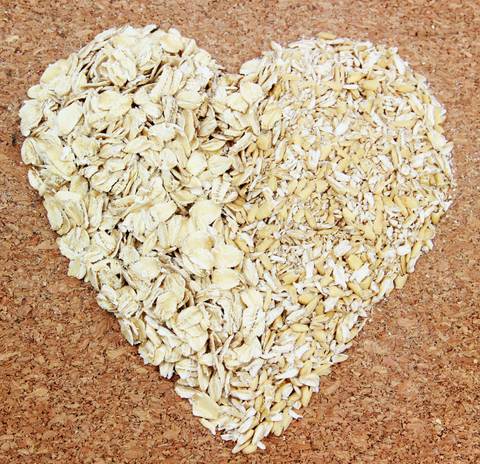Oats are a grain that has been used for eons. It’s thought by some that the 2000 years ago Egyptians used oats to soothe their skins. Others think the Egyptians never cultivated oats and that the Bronze Age was when oats were first cultivated. Rumor has it that the Scots ate oats while the English only fed them to their horses. The Scottish response to this was, “That’s why England has such good horses, and Scotland has such fine men!” (Gibson & Benson 2002)
Colloidal oats are a fairly recent addition to the use of oats. As near as anyone can figure they emerged around 1945 when finely ground oats were made available.
Today we’re still discovering all the magic contained in oats. So this post is for you whether you are using oats in skin and hair formulations or for eating. It’s for you if you want to know whether you should purchase steel cut oats or rolled oats. It’s for you to discover the magic of oats.
Types of oats you can purchase
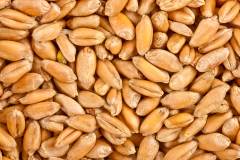
Oat Groats: This is the whole grain with only the outer husk removed. Oat groats go through a single steaming process or they are kiln heated to protect against rancidity. Bob’s Red Mill Natural foods uses kiln heating according to Chelsea Lincoln of Bob’s Red Mill Natural Foods and Stephanie Haney of Quaker Oats told me that they steam their groats.
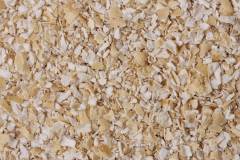
Oat Bran: This is oat grain (groats) less much of the endosperm. The endosperm is the innermost portion of the grain which is used to make oat flour.
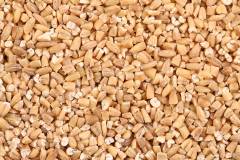
Steel Cut Oats: The oat groats are run through steel blades that slice them into small chunks.
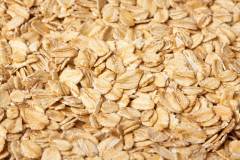
Old Fashioned Rolled Oats: These are oat groats that are run through rollers to flatten them. They are then toasted to enhance their flavor according to Stephanie Haney.
Quick Cook Oats: These are finely cut old fashioned oats.
Instant Oats: Partially cooked and often have sweeteners and flavorings added. Not much magic in these oats.
About the magic of oats (Avena sativa L)
Most foods that are healthy work from the inside of us after we eat them. Oats work wonders for our bodies both from the inside and the outside.
From the inside
- Oats are low fat somewhere between 130 and 170 calories per serving. Of course, the calories go up if you’re like me who loves them with butter, milk, and honey or brown sugar on them, but I can’t blame the oats for my bad habits.
- One serving of oats gives you about 4 or 5 grams of fiber or about the same as 1 large apple. Studies have shown that the fiber, beta glutan, found in oats helps keep HDL, the good cholesterol, up and LDL, the bad cholesterol, down. Think nice healthy arteries and heart. Plus, get this, studies also show that the beta glutan in oats enhances your immune system.
- The protein in oat grain is nearly equal to that of meat, milk, and eggs. Just in case you’re interested, the protein in oats is called is avenalin and the oat is the only grain that contains this protein source.
- According to the American Diabetes Association, both steel cut oats and whole grain rolled oats have a low glycemic index (they are slow to raise blood glucose levels). Quick oats have a medium glycemic index.
- Oats contain no gluten. According to the Quaker oat company, there may be some cross-contamination when transporting oats or when the mill used to process them also processes wheat and other grains containing gluten. You might be interested in one study conducted on children with celiac disease (gluten is intolerable to folks with celiac disease) and the tiny amounts of gluten in rolled oats were well tolerated. That said, you can purchase guaranteed gluten-free oats such as that carried by Bob’s Red Mill Natural Foods.
- Oats and other grains contain plant lignans. These are noted for their antioxidant and phytoestrogenic (estrogen derived from plants) qualities. Studies indicate they may help prevent breast, prostate and other hormone-related cancers as well as heart disease.
- Oats are high in antioxidants which help protect you from that fast food diet high in artificially produced trans fats. Trans fats damage our arteries, increase our LDL(the bad cholesterol), make us fat and cause heart attacks.
From the outside
- You can use oats on your skin as a cleansing and softening scrub. Check out the post “Homemade Sugar Scrub.”
- Have a rash, eczema, psoriasis or itchy skin? Numerous studies indicate oatmeal (particularly colloidal oatmeal) helps to heal and soothe the skin. We can particularly thank the polyphenol, avenanthramide for this. Avenanthramide is found “exclusively in oats” according to a 2011 article which appeared in the Journal of Agricultural and Food Chemistry. Check out the post “Colloidal Oatmeal – A Really Really Simple Bath for Dry Itchy Skin.”
- Have a few wrinkles or maybe a lot of wrinkles? Use colloidal oatmeal to make your skin healthier and diminish the wrinkles. Colloidal oatmeal helps to repair damaged skin. Check out the post “Colloidal Oatmeal Cream Recipe.”
- Have problems with your hair and or scalp? Use colloidal oatmeal to help solve the problem. Check out the post “Homemade Conditioner – Colloidal Oatmeal.”
- Does your skin feel rough? Take a colloidal oatmeal bath and watch it become smooth and moisturized. Check out the post “Colloidal Oatmeal – A Really Really Simple Bath for Dry Itchy Skin.”
- All this plus you get a sunscreen. (Further explanation follows below.)
Oats contain the following:
- Protein 15 – 17%
- Starches and sugars 59 – 70% These sugars include beta glucan (beta glucan concentrations range from 2 – 6%) – The sugars and starches are the protective and water holding function of oats with beta glucan being of primary interest as its function in lowering cholesterol.
- Fat 4 – 9%
- Dietary fiber 5 – 13%
- Saponins – The saponins in oats are mostly what give them their cleansing properties.
- Polyphenols – Some of the phenols in oats protect against UVA in the range of 320 – 370nm. (The total UVA spectrum ranges from 320 to 400 nm and is associated with cell damage, skin cancers, and aging). Of particular interest are the avenanthramides for their role as anti-histamines and antioxidants.
- Various vitamins 3 – 11%
- Minerals in whole grain oat – Very small percentages of copper, manganese, zinc and iron. Higher percentages of Calcium (95mg/100g), magnesium (140mg/100g), sulfur, phosphorus (340mg/100g) and potassium (460mg/100g).
Steel Cut Oats vs. Rolled Oats
The steel cut oats will take longer to cook (10 minutes or more depending on how soft you like them), but they have a delicious nutty flavor and any leftovers can be fried. (I love them fried. And so simple that even I can make them.) The rolled oats are quicker to cook, but you have to take care that you are purchasing a rolled oat that is made from whole grain oats. Some rolled oats have a portion of the bran (the outside part of the grain) removed. Also, because rolled oats have gone through the toasting process, they are slightly less nutritious than steel cut oats. Steel cut oats also have a lower glycemic index than rolled oats because they take longer to digest. That makes steel cut oats preferred for personal care products and cooking.
How to make colloidal oatmeal
You can buy either uncut oats or steel cut oats, but steel cut oats are easier to find than uncut oats. Whatever you use, grind the oats in a coffee grinder to fine flour. To determine if the oats are fine enough, add a small amount to warm water. If fine enough, the oats will suspend in the water. If they sink to the bottom, you will need to grind them a little more and retest.
There, now you have it. Probably way more than you needed or wanted to know about oats, but I couldn’t help myself. Oats are so amazing that I got carried away. The truth is that oats to eat or prepared as colloidal oatmeal for your hair and skin formulations are a wonderful gift to us from Mother Nature. They are truly magical when you consider just how many benefits they offer. Plus, they are not only delicious, they’re very affordable. For instance, I priced steel cut oats from $3 to $11 for 24 Ounces (The prices were for the same brand online). If you’re a thrifty shopper and pay the lower price, you get 15 servings for about 20 cents a serving.
Tip: I suggest you buy organic grains they don’t cost that much more and you’re supporting the organic growers while avoiding possible pesticide and or herbicide contamination.
Now go have fun and relax.
Related articles:
Homemade Conditioner – Colloidal Oatmeal

